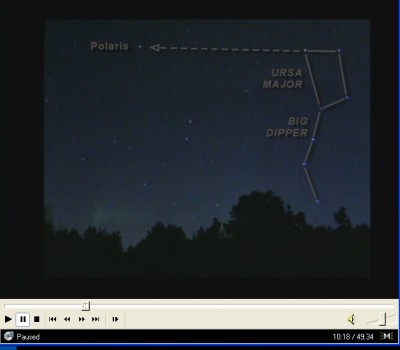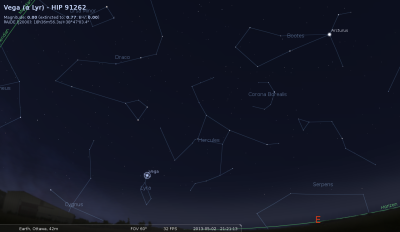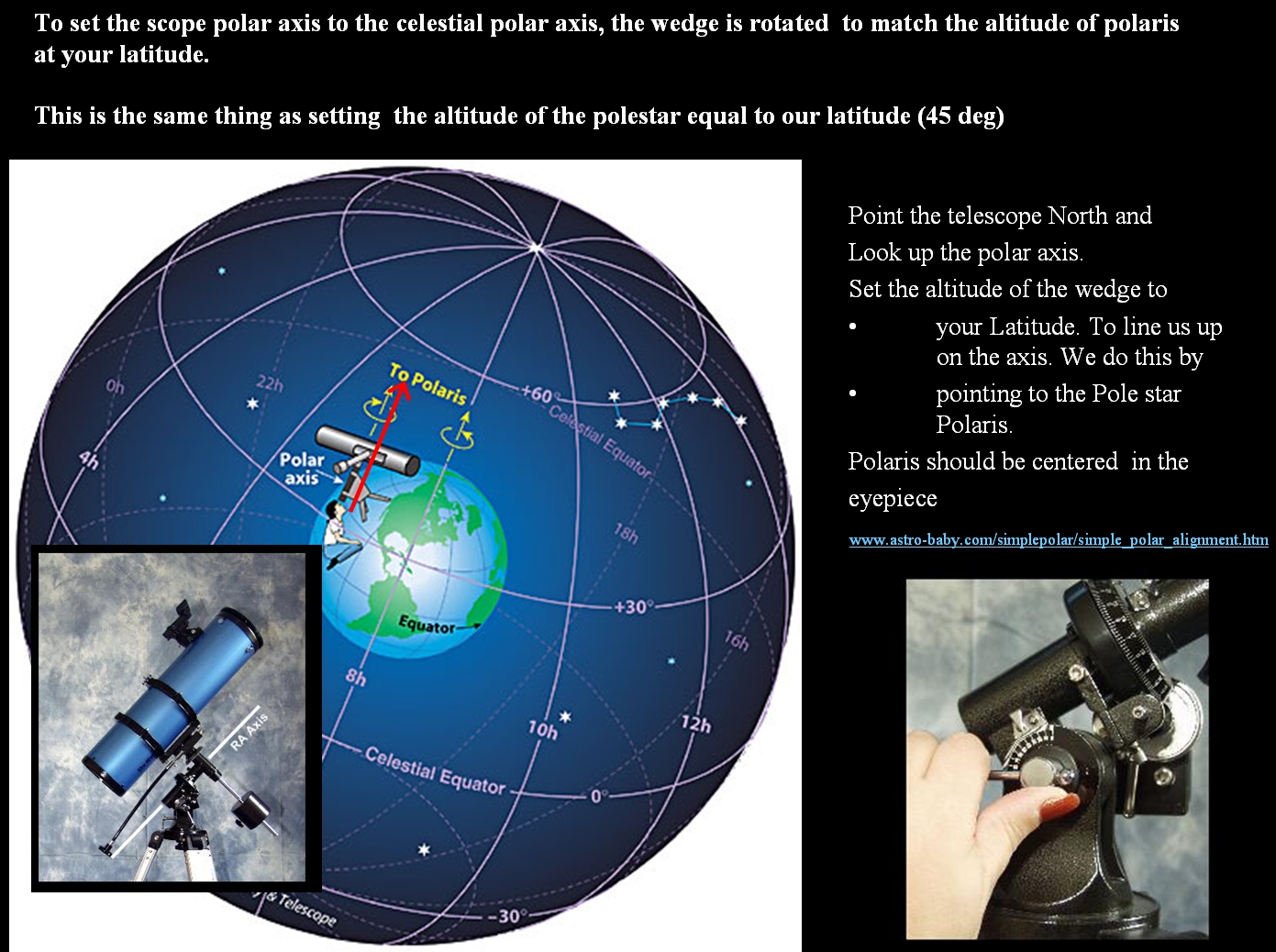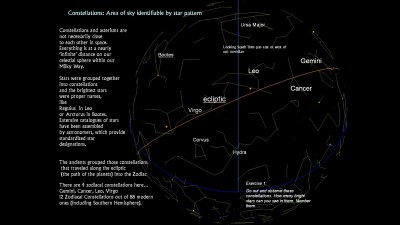by Pat Browne
Observational Points
Many folks had really good questions throughout the evening. It’s a good idea to capture some of these points and tease out the data from what we observed. I will attempt to deal with points chronologically, starting with the questions from the beginning of the evening to the later, perhaps deeper questions as we peered further out into space.
You can also review the lecture here: Night Sky Lecture 1
Question: How do we find Polaris?
Answer: Use the pointer stars of the Big Dipper

Question: How do we find out what moons of Jupiter we were looking at on the night of our observation?
Answer: Use Stellarium to zoom in on the night of your observation:
See the NightSky News link: Jupiter – Dance of the Moons
Question: Roughly speaking… How far away from earth is Jupiter (in kilometers for example)?
Answer: If we know how long it takes for light to travel from the planet to earthlings, we can do a rough calculation:
It takes roughly 40 minutes for light from Jupiter to reach earth. The speed of light is roughly 300,000 km/sec.
So: 300,000km/sec x 40min x 60min/sec ~ 720 million kilometers…
That’s why it took so long for Galileo spacecraft to get there!
Question: What is an A.U.?
Answer: The A.U or Astronomical Unit is the average distance between the Sun and Earth. Its value is 149,597,870 km (~150 million kilometers. ) It is R(E) in the diagram.
Incidentally Last year, when the class took a field trip to observe the Transit of Venus, we learned about the historical significance of Transit of Venus observations; attempts were made by astronomers to determine the A.U distance by observing the disk of Venus travel across the sun (at Inferior Conjunction). This method required that the baseline of the earth be used requiring an expedition by two teams of observers. The science of the day was to measure the Earth – Venus distance, and knowing the relative measures of planetary orbits around the sun, one could work out the Earth-Sun distance:
https://millstonenews.com/2012/06/observing-the-transit-of-venus-what-we-learned.html

See also: http://spiff.rit.edu/classes/phys445/gettys/venus_ex/venus_ex.html
Regarding A.U.s, We can use this unit to measure the Earth-Jupiter distance directly: We use the fact that Jupiter is roughly 4.2 A.U’s earth-sun distances away from earth when (5.2 AUs from the Sun). An A.U. or astronomical unit is about 150,000,000 kms. Hence Earth-Jupiter distance is 4.2 x150,000,000 ~ 630 million kms .
Question: Why are planets so hard to keep centered in the telescope eyepiece?
They seemed to float out of view very quickly.
Answer Because the distance to the planets is small with respect to the background stars, and because the rotation of the earth has an effect at this scale, the planets will float out of view as the earth rotation produces miniscule but observable changes in position of the planet. Note that this is not true if the telescope were mounted on a tracking mount. An equatorial telescope is built so that you an adjust Right Ascension axis parallel to the earths rotational axis. If this is done accurately enough, all that is necessary to keep the telescope pointing at a planet is to move this one axis at a rate equal and opposite to the rate the earth rotates.
A simple example of a tracking mount is called an Equatorial Mount. Aligning the telescope to a fixed point in the sky which isn’t moving allows you to track objects using the Right Ascension control (knob). The Right Ascension movement compensates for the earth’s movement and allows the telescope to ‘track’ an object. The part of the sky which doesn’t move is of course the North Celestial Pole ( if your in the Northern hemisphere ) which is rather like a hub around which the stars appear to rotate. Adding an electronic ‘clock drive’ to the mount so move the scope ever so slightly at the sidereal (or earth rotation ) rate of 15 deg/hour or equivalently 15 arc-sec/sec.
Note: If you wish to use manual setting circles:
After you complete your polar alignment, (where the declination is at 90), slew the telescope to a bright star for which you know the Right Ascension and Declination (celestial equivalents of Longitude and Latitude on earth).
- Set your RA setting circle to the RA of the star.
- Set your DEC setting circle to the Declination of the star .
Question: What is a light year?
Answer: The light year (or light-year or lightyear) is a measure of distance, that light travels in space in one year. Since the speed of light is about 300,000 km per second (about 186,000 miles per second), then a light year is about 10 trillion kilometers (about 6 trillion miles). A light year is not a length of time. The light year is used in astronomy because there are objects in space several orders of magnitude further out than the planets! Space objects such as stars and galaxies may be hundreds, thousands or millions of light years away.
Example: Think of a star at a distance of 100 light years from us on Earth. Light leaves the star and takes 100 years to get to us. When we see the star’s light, we are seeing that star as it was 100 years ago. Similar distance measurements:
Light minute – The distance that light travels in one minute (about 18,000,000 km per minute, or 11,160,000 miles per minute).
- The Sun is about 8 light minutes from Earth Therefore Jupiter which is roughly 5 A.U. is about 40 light minutes from Earth so that light leaving the planet arrives at our telescope 40 minutes later.
- At a larger scale, the galaxies in the Leo Triplet are 35 Million light years distance. Light that we see from these objects originated 35 million years ago (in time) from that distance. Light second – The distance that light travels in one second (about 300,000 km per second, or 186,000 miles per second)
Question: What was that mysterious scintillating(low) blue/white star seen in the NorthEast? Answer:
The star was Vega, one of the stars of the Summer Triangle spanning 3 summer constellation. The Summer Triangle is an asterism which includes Deneb (constellation Cygnus) and Altair(constellation Aquila) and Vega (Lyra)
Question: What was that mysterious scintillating(low) blue/white star seen in the NorthEast?
Answer:
The star was Vega, one of the stars of the Summer Triangle spanning 3 summer constellation. The Summer Triangle is an asterism which includes Deneb (constellation Cygnus) and Altair(constellation Aquila) and Vega (Lyra)
Vega’s spectral class is A0V, making it a blue-tinged white main sequence star that is fusing hydrogen to helium in its core.

Question: What were bino-viewers observing when they trained their binos on Mizar?

Binocular View
Answer: Mizar and Alcor
However even without Alcor, Mizar takes its place in the celestial hall of fame as the first known double, one that consists of a pair of stars that orbit each other. Found to be double in 1650, Mizar is a prime target for someone with a new telescope, as the components are an easy 14 seconds of arc apart (at least 500 astronomical units), the two taking at least 5000 years to make their orbit about each other.
So in one star field (depending on your field of view!) we can see
- a true binary system in Mizar (telescopically at 14 ” (arc-secs) apart)
- or the visual double Alcor and Mizar (4 ‘ (arc-mins) or roughly a factor of 60 larger field of view).
Question: How can you tell the difference between Open Clusters (like the Beehive Cluster, M44) and Globular Clusters (like M 53 or M3)


Answer:
Stars congregate in two different types:
- Open or Galactic Clusters : Open clusters lie within the plane of the galaxy,and contain from a few to 100 stars ‘born’ from a common cloud of dust and gas. The distance to these objects is usually < 1000 light years. Open clusters can be seen using binoculars.
- Globular Clusters: Globular clusters are tightly packed balls of hundreds of 1000s of older stars that lie in a halo around the central hub or our galaxy. Part of the fun of observing globular clusters is to try and resolve individual stars. Globular clusters are best viewed in a telescope.
Question: How can you tell the difference between clusters and Galaxies, and what exactly are Galaxies?
Answer:
“Galaxies are a monstrous collection of billions of stars, along with gas and dust. Galaxies are
classified as irregular, spiral or elliptical. We saw these galaxies last week. We experience a huge exponential change in distances as we leave the Milky Way and the mighty globular clusters that surround it. Instead of distances in the tens of thousands of light years, we visited [Ed.] objects millions of light years away….” Courtesy David Levy, Deep Sky Objects
Question: How are Distance and Brightness of the Objects that we saw related?
(Click on the image to enlarge)
Question How do we Plan and Do an Observing Session?
Answer Here’s a checklist:
Plan:
- Get a book from the library or a magazine that features a particular selection of objects visible from your location at the current date
- You can use tablets but plan what you are doing beforehand so that you don’t just stare at the screen
- Better to plan indoors first.
- Use a planetarium program like Stellarium. We can do a lab showing how to set the time, place, information detail, catalogues…
- Use a star atlas like Pocket Star Atlas or Star Atlas 2000
Do:
- Make sure you are comfortable at the eyepiece, find a chair or stool to sit on. You can sit down when you get tired.
- Choose an area to work on and pick from a list of different things:
- Stars with colour or colour contrast if a binary system
- Star nebulae and nurseries and novae remnants
- Star clusters
- Galaxies
- Clusters of galaxies
Question When I looked through the telescopes, what typical magnifications were we using?
Answer It depends on the telescope and the eyepiece. We were using low-power eyepieces and small reflector telescopes.For example, the little StarGazer Steve red scope is a 6″ aperture (primary mirror) and a focal length muliplier of 8. This comes to 48″ or 4-ft. It is roughly the length of the tube assembly. So for a given eyepiece we measure:
Magnification = Aperture X Focal Length (Scope)
-----------------------
Focal Length (eyepiece in mm)
For a wide field view we used a 24mm eyepiece and the aperture was 6", and the Focal
(F.L) was F8 (8x)
Magnification = 6" x 8 x 25.4 mm/inch
------------------ = 50X
24 mm
The most pleasing view in this scope is the eyepiece designed for this scope which is 18mm
i.e. 2/3 or 66X
Wide fields are ‘rich fields’. We can take in more of the cluster or more than 1 galaxy if we are looking at clusters.
To do close-up work,to split doubles, or look at the detail on the planet – that’s when we want higher power! For this we would use 8mm (150) or smaller.
Question What Constellations can we practice in the early evening in May?
(click to enlarge the image…)







